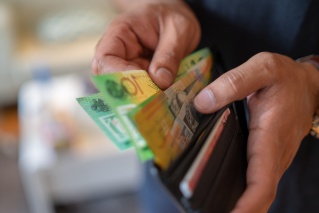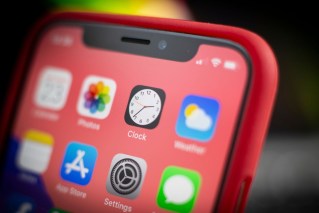When ‘girl math’ adds up, any extravagance makes sense


According to 'girl math', this ardent shopper has saved herself a fortune. Photo: Getty
“Girl Math” is the newest TikTok craze, designed to allow you to rationalise, if not entirely justify, the cost of pretty much any purchase, no matter how expensive.
The basic idea is about convincing yourself that some purchases are free, or are actually about putting money back in your pocket, depending on how you justify it. Following along? Great.
The term was popularised on Fletch, Vaughan & Hayley, a New Zealand radio show which features a segment where listeners tell the hosts about the cost of recent purchases.
Creative accounting
One time, Kelsey needed help justifying her new Dyson Supersonic hairdryer, which set her back $699 (retailing for $649 in Australia), that she insists is “definitely worth the money”.
On-air, Hayley pointed out that this particular hairdryer promises to help get rid of fly-aways, which both she and Kelsey struggle with.
The pricey hairdryer is then riddled down using “girl math”, taking into account things like not needing to buy hairspray or mousse, or not needing to go to the doctors because wet hair caused a cold.
@fvhzm #itsbasicallyfree but it’s also basically a secondary income 💁♀️ Let us know if you need us to #girlmath one of your purchases! 🤪
On top of that, Kelsey is saving time because this new hairdryer is so efficient, plus maybe her friends will want to use it when they’re going out and then show their gratitude by buying her drinks.
It’s not hot air
Hayley did try to reduce the cost of the hairdryer by breaking it down “per strand” of hair. The kicker came when they worked out Kelsey, instead of going to a salon, was actually “making money” by using her hairdryer.
A blowout at a salon would easily be $100. Kelsey uses her hairdryer three to four times per week, which amounts to more than 150 times per year. If she were to get her hair blow dried at a salon, instead of using her own appliance, it would be $300 per week, which works out to be $15,000 per year.
“That’s $15,000 she’s saving, so $15,000 minus the original $699, you’ve actually made $14,301 by buying this Dyson,” Hayley determines.
And that is “girl math”. It’s not actual financial advice and it’s all intended to be fun – but in some cases it can be helpful.
Speaking to Refinery 29, Hayley said the segment started off-air when the show’s producer was in need of getting her hair done and the show’s social media producer “started organically girl-mathing it”.
“I jumped in and the boys were gobsmacked at how we got the cost of her haircut down to next to nothing – basically free – so we put it on air,” she said.
The show hasn’t just helped with hair-related “girl math”, the hosts also have helped rationalise buying tickets to Taylor Swift’s The Eras Tour (with flights and accommodation on top of tickets), an Italian silk dress and a $1000 bag.
Depends how you look at it
Since the Fletch, Vaughan & Hayley skit went viral, people have been sharing their “girl math” rules on TikTok.
The rules are different for everyone. For some, anything under $5 is free, for others anything bought with cash is free. Likewise, if you don’t buy something on sale, you’re losing money.
There’s a general consensus that a concert or event is free if you paid for the ticket months in advance. Not buying a coffee at a cafe one day is making money, so is returning an item after purchasing it.
@danielasotohealth Girl math makes me feel seen 🥹#greenscreen #girlmath #girlmaths
@parisinthewild Girl math is the only logic i care about 🥰 #travelcreator #traveltiktok #traveltok #travellife #travelbucketlist #traveltips
The possibilities are endless – and quite funny, especially when men are informed about “girl math” and end up being utterly confused.
While a lot of the “girl math” content is just for fun, there are aspects that are helpful, like using it to work out the cost-per-wear of an item.
One girl used a $5000 bag as an example, which sounds like a lot until you break it down by cost-per-wear.
If she were to use the bag every day for 10 years, the $5000 bag’s cost-per-wear would be $1.30 and if a bag lasts that long, it’s arguably a good investment.
@ta.shiya PSA to all the boys! 🙄 #girlmath
Sexist undercurrent
Just like “girl dinner” and “hot girl walks”, “girl math” is intended to be fun, however, some financial experts have expressed concerns about the trend.
Former JP Morgan equities trader and upcoming author Vivian Tu reminded people that small costs, even things priced at less than $5, do add up.
“A $5 purchase every day that ‘doesn’t count’ leads to an extra $1,825 in expenses annually,” she told the Huffington Post.
“It’s totally OK to want to spend money and enjoy spending money, but doing it with intention means you not only get to enjoy your purchase, but you also won’t end up with a deficit in your budget.”
Speaking to Refinery 29, investor and entrepreneur Tori Dunlap offered an explanation why “girl math” has become so popular on social media. She explained some financial experts will advise people to stop spending money on unnecessary things.
“It’s ‘stop spending money on lattes or manicures or designer bags.’ It’s not NFL season tickets or video games or golf clubs,” Ms Dunlap said
“We’re told that the reason we’re not rich is because we’re spending money, and then we’re told to stop spending money on things that are innately feminine. We’re being told that those things aren’t worth your money and aren’t valuable.”








